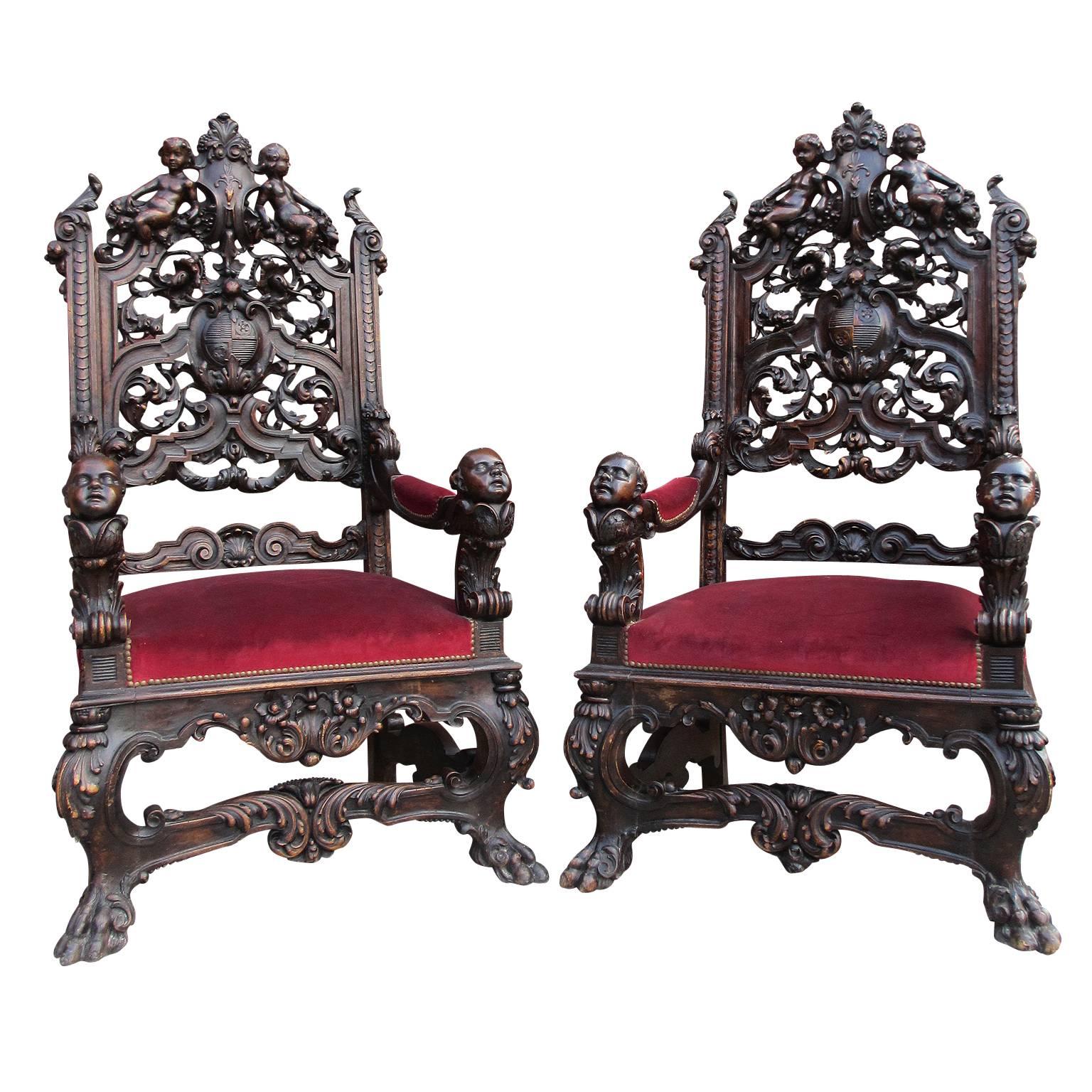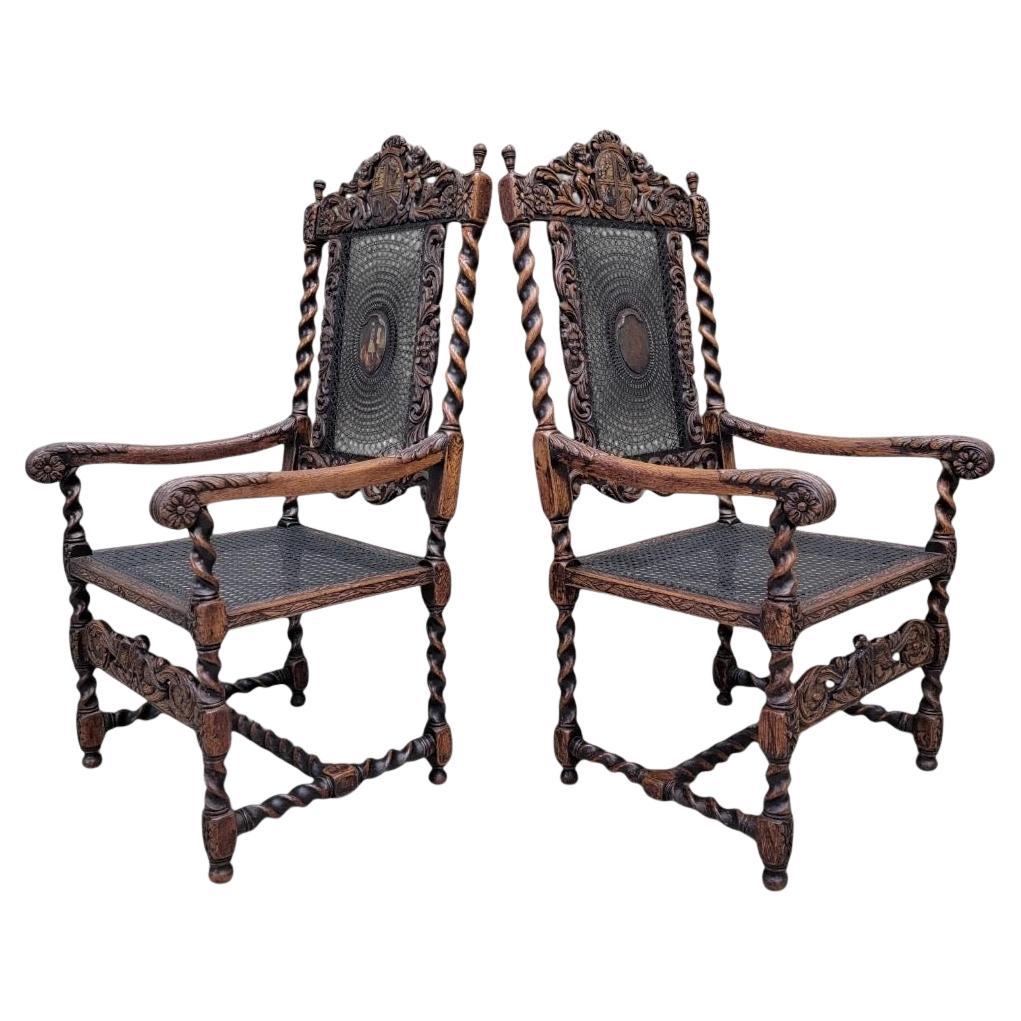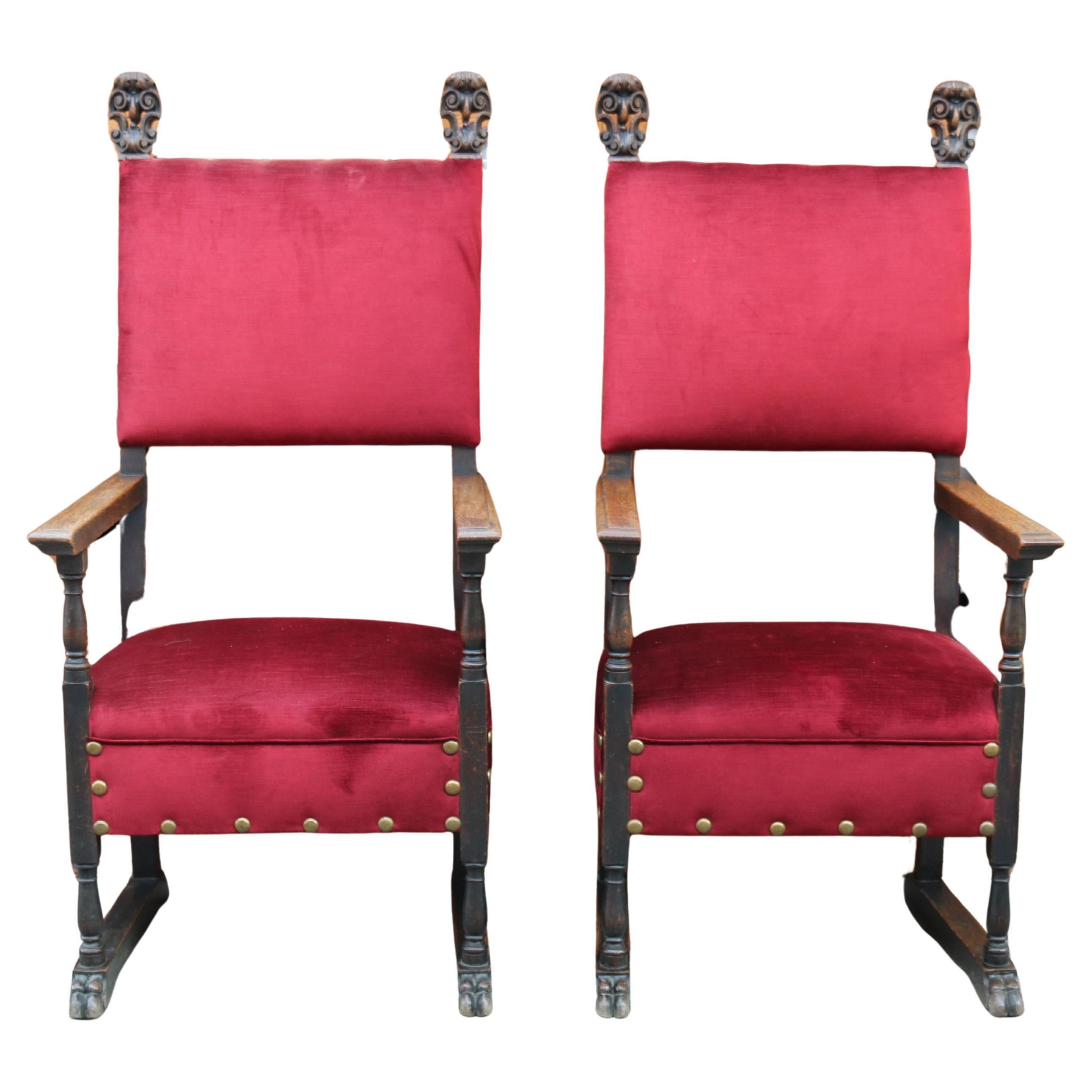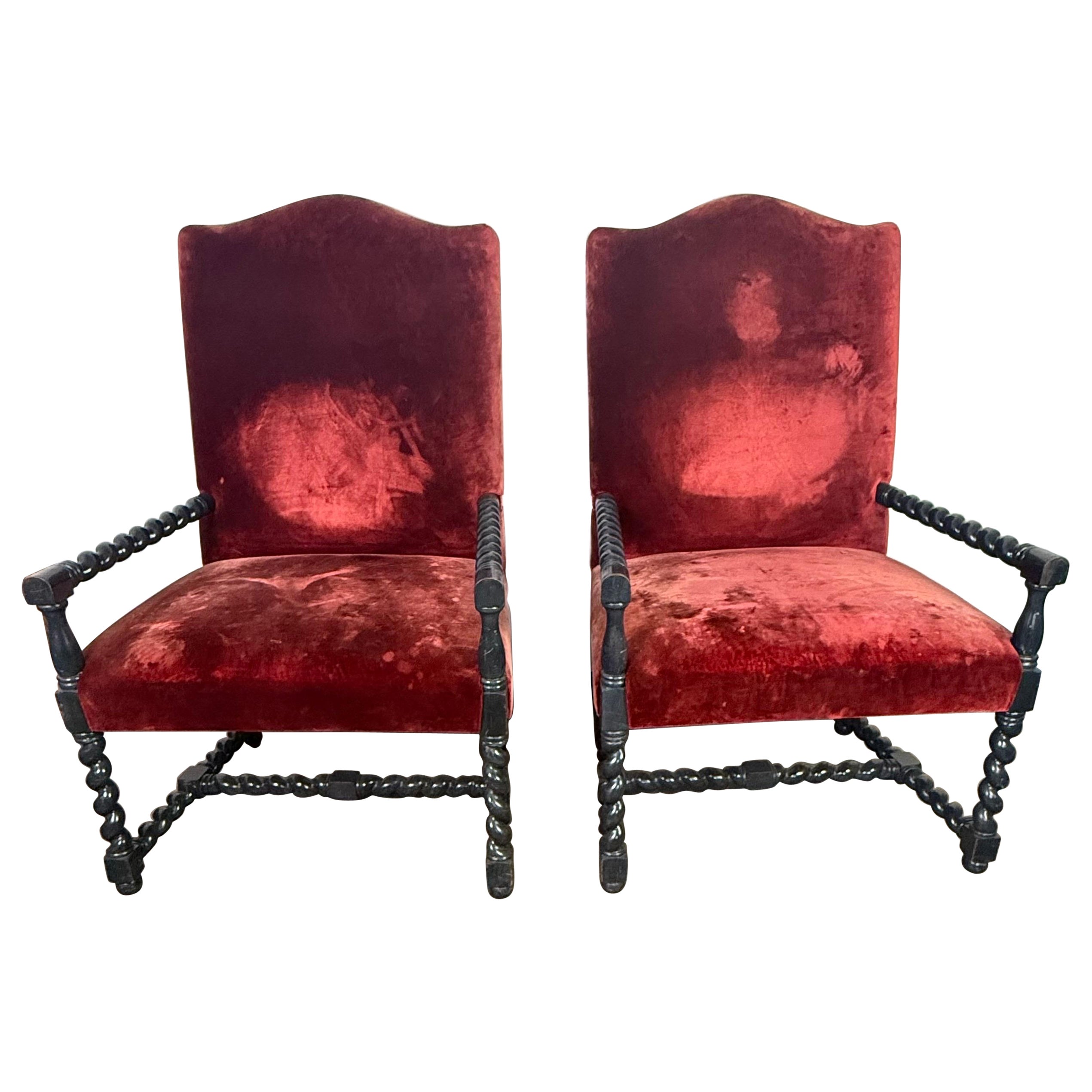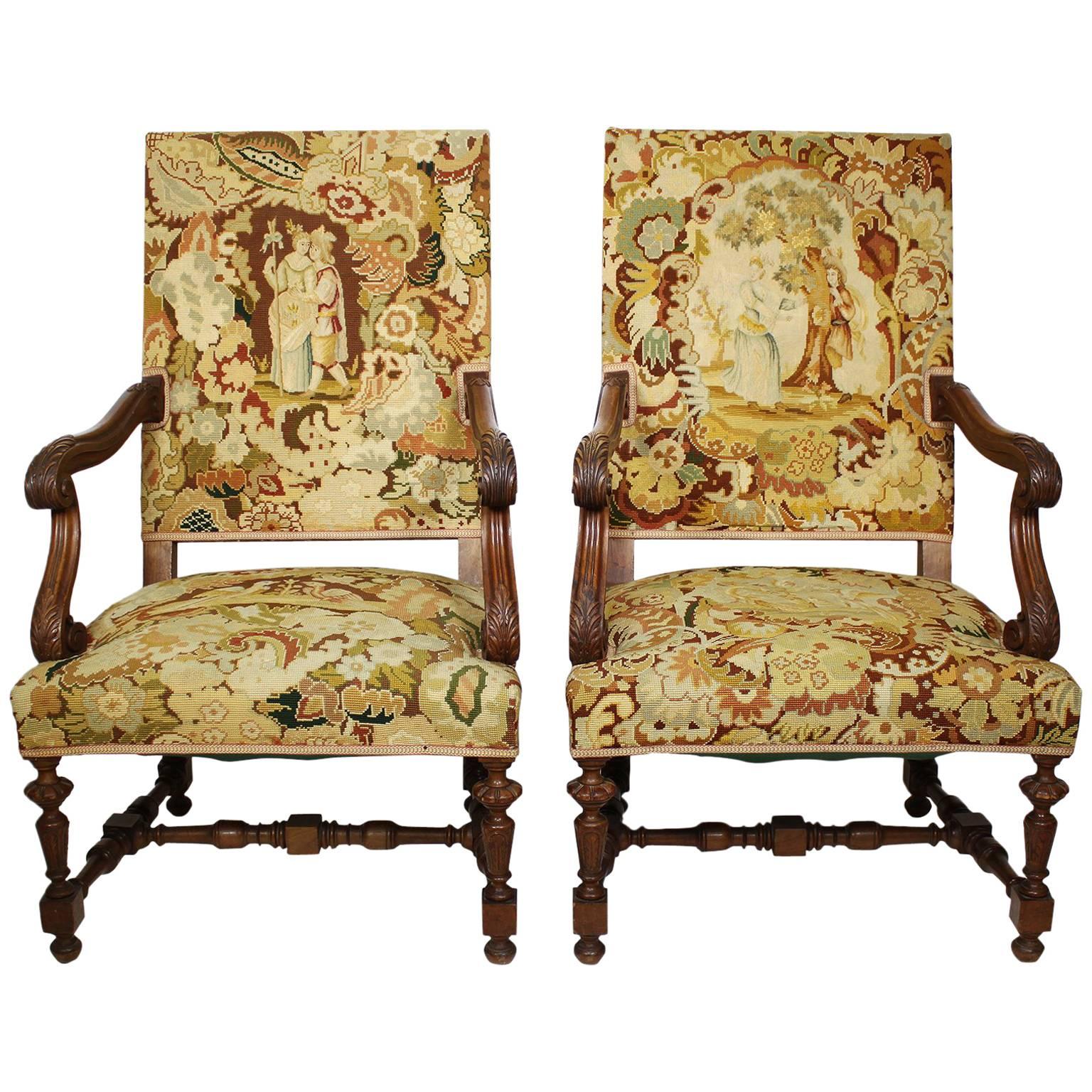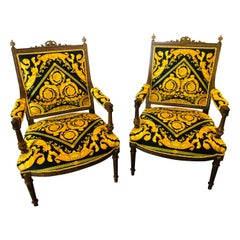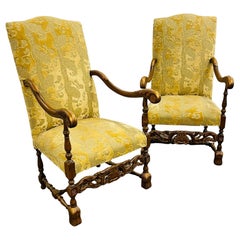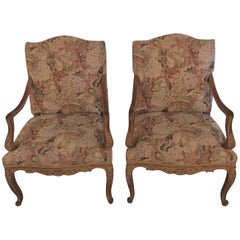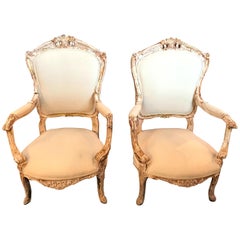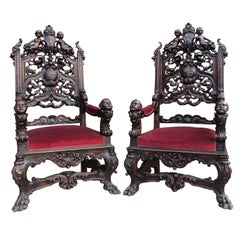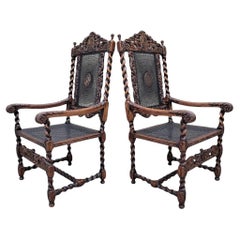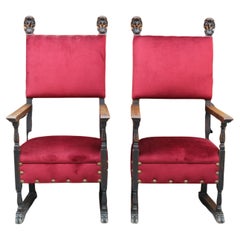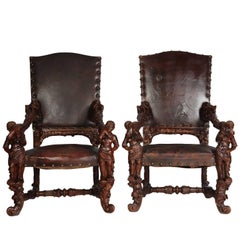Items Similar to Pair of Italian 19th Century Baroque Carved Arm Throne Chairs, Figural Carvings
Video Loading
Want more images or videos?
Request additional images or videos from the seller
1 of 22
Pair of Italian 19th Century Baroque Carved Arm Throne Chairs, Figural Carvings
$34,200per set
£25,725.59per set
€29,653.04per set
CA$48,174.49per set
A$52,858.89per set
CHF 27,663.88per set
MX$650,513.87per set
NOK 348,523.43per set
SEK 326,444.12per set
DKK 221,416per set
About the Item
Pair of Italian 19th century Baroque carved arm throne chairs. The pair with figural carvings and putti sleeping on beds of leafs, attributed to Valentino Panciera Besarel (Venice, 1829-1902) in the manner of Andrea Brustolon (1662-1732). The ornately carved thrones, each flanked with figures of standing males supporting a branch-carved armrests with vines. Raised on cabriolet scrolled legs.
Andrea Brustolon (20 July 1662–25 October 1732) was an Italian sculptor in wood. He is known for his furnishings in the Baroque style and devotional sculptures.
Biography
He was trained in a vigorous local tradition of sculpture in his native Belluno, in the Venetian terraferma, and in the studio of the Genoese sculptor Filippo Parodi, who was carrying out commissions at Padua and at Venice (1677). He spent the years 1678-1680 at Rome, where the High Baroque sculpture of Bernini and his contemporaries polished his style. Apart from that, the first phase of Brustolon's working career was spent in Venice, 1680–1685. Brustolon is documented at several Venetian churches where he executed decorative carving in such profusion that he must have quickly assembled a large studio of assistants. As with his contemporary in London, Grinling Gibbons almost all the high quality robust Baroque carving in Venice has been attributed to Brustolon at one time or another. In the Venetian Ghetto, at the Scola Levantina, Brustolon provided the woodwork for the synagogue on the piano nobile, where the carved, canopied bimah is supported on Solomonic columns, which Brustolon had seen in Bernini's baldacchino in the Basilica of St Peter's.
His furniture included armchairs with figural sculptures that take the place of front legs and armrest supports, inspired by his experience of Bernini's Cathedra Petri. The gueridon, a tall Stand for a candelabrum, offered Brustolon unhampered possibilities for variations of the idea of a caryatid or atlas: the familiar Baroque painted and ebonized figural gueridons, endlessly reproduced since the 18th century, found their models in Brustolon's work.
His secular commissions from Pietro Venier, of the Venier di San Vio family (a suite of forty sculptural pieces that can be seen in the Sala di Brustolon of the Ca' Rezzonico, Venice), from the Pisani of Strà, and from the Correr di San Simeone families encourage the attribution to him of some extravagantly rich undocumented moveable furniture. Andrea Brustolon's elaborate carved furniture aspired towards the condition of sculpture, such as the Dutch bases for console tables which look like enlargements of the work of the two Van Vianens, Paulus and Adam, perhaps the greatest Dutch silversmiths of the period. These carved pieces display the Baroque tendency to develop a form three-dimensionally in space.
Brustolon's walnut, boxwood and ebony pieces transcend ordinary functional limitations of furniture; they are constructed of elaborately carved figures. The framework of Brustolon's chairs, side tables and gueridons were carved as gnarled tree branches, with further supports of putti and male figures carved in ebony. Backrests of the chairs, which were never touched in the rigidly upright posture that contemporary etiquette demanded, were carved with allegories of vanity, fire and music, etc.
The most extravagant piece delivered for Pietro Venier was a large side table and vase-stand of box and ebony, designed as a single ensemble to display rare imported Japanese porcelain vases. The eclectic allegories include Hercules with the Hydra and Cerberus, males and reclining river-gods (see ref.).
For the Correr, less extrovert chairs bear female nudes extended along the armrests. For the Pisani, he carved a suite of twelve chairs (now at the Palazzo Quirinale) with flowers, fruit, leaves and branches to symbolize the twelve months of the year. Work by Brustolon is at the Villa Pisani at Stra.
In 1685 Brustolon returned to the house where he was born at Belluno, and from that time devoted himself mainly to tabernacles and devotional sculptures in walnut, boxwood or ivory. His polychromed ivory Corpus from a crucifix is in the Museo Civico di Belluno, which preserves some of Brustolon's preparatory drawings for frames to be carved with putti displaying emblems. A pair of boxwood sculptures, The Sacrifice of Abraham and Jacob Wrestling with the Angel, integral with scrolling barocchetto stands, were in the collection of Justus Liebig (Liebigshaus, Frankfort). An altarpiece, circa 1720, is at the Victoria and Albert Museum, London.
He died in Belluno in 1732.
Valentino Panciera Besarel (1829-1902) was Andrea Brustolon's great heir of the 19th century in wood carving; he presented himself as Brustolon's natural successor and alter ego. He studied from 1855-1857 in Venice and his career developed the most in there and in Belluno, although it was also turned to countries beyond the Alps. He applied in furniture and in ecclesiastical and secular decoration, showing his talents in furniture and frames making.
References:
Catalogue by Massimo de Grassi, Valentino Panciera Besarel, Verona, 2002) and was the subject of a monograph, Giovanni Angelini, Gli Scultori Panciera Besarel (Belluno 2002).
Biasuz G., and Buttignon M.G., 1969. Andrea Brustolon (Istituto Veneto Arti Grafiche) 1969
Gonzales-Palacios, Alvar, 1967. Il mobilio del '700 veneto
Semenzato, G., 1967. La scultura veneta del Seicento e del Settecento (Turin: Alfieri)
Valcanover, F., 1960. Indice delle opere d'arte della città e provincia di Belluno (Venice)
Biasuz, G., and E. Lacchin, 1928. Brustolon, preface by U. Ometti (Venice: Zanetti).
- Dimensions:Height: 51 in (129.54 cm)Width: 37.5 in (95.25 cm)Depth: 31 in (78.74 cm)Seat Height: 21.5 in (54.61 cm)
- Sold As:Set of 2
- Style:Baroque (Of the Period)
- Materials and Techniques:
- Place of Origin:
- Period:
- Date of Manufacture:1880s
- Condition:Wear consistent with age and use. Minor fading.
- Seller Location:Manhasset, NY
- Reference Number:Seller: 101-49731stDibs: LU863219328682
About the Seller
4.9
Platinum Seller
Premium sellers with a 4.7+ rating and 24-hour response times
Established in 1975
1stDibs seller since 2009
1,793 sales on 1stDibs
Typical response time: <1 hour
- ShippingRetrieving quote...Shipping from: Manhasset, NY
- Return Policy
Authenticity Guarantee
In the unlikely event there’s an issue with an item’s authenticity, contact us within 1 year for a full refund. DetailsMoney-Back Guarantee
If your item is not as described, is damaged in transit, or does not arrive, contact us within 7 days for a full refund. Details24-Hour Cancellation
You have a 24-hour grace period in which to reconsider your purchase, with no questions asked.Vetted Professional Sellers
Our world-class sellers must adhere to strict standards for service and quality, maintaining the integrity of our listings.Price-Match Guarantee
If you find that a seller listed the same item for a lower price elsewhere, we’ll match it.Trusted Global Delivery
Our best-in-class carrier network provides specialized shipping options worldwide, including custom delivery.More From This Seller
View AllPair of 19th-20th Century Louis XVI Style Carved Armchairs
By Gianni Versace
Located in Manhasset, NY
Pair of 19th-20th century Louis XVI style finely carved armchairs in Gianni Versace Fabric. These spectacular one of a kind antique walnut fauteuils or ...
Category
Early 20th Century French Louis XVI Armchairs
Materials
Wood
$8,500 Sale Price / set
26% Off
Pair of Throne Chairs, Fauteuils in Louis XIV Fashion, Fine Upholstery
Located in Manhasset, NY
Pair of Throne chairs or fauteuils each with an arched back and padded seat joined to open arms with parcel-gilt foliate- and rosette-carved hand...
Category
Mid-20th Century French Jacobean Lounge Chairs
Materials
Fabric, Wood
Pair of Distressed Finely Carved Louis XV Style Fauteuils Manner Jansen
By Maison Jansen
Located in Manhasset, NY
A pair of distressed finely carved Louis XV style fauteuils manner Jansen. The worn and distressed Louis XV style frames are wonderfully carved hav...
Category
Mid-20th Century Louis XV Armchairs
Materials
Wood
$1,620 Sale Price / set
46% Off
Pair of Antique Louis XV Style Armchairs in Painted Distressed Frames
Located in Manhasset, NY
A pair of antique Louis XV style armchairs in painted distressed frames. Each having a wonderful antique frame that has been washed wit...
Category
Mid-20th Century French Louis XV Armchairs
Materials
Wood
Pair of Louis XV Style Bergère Armchairs
Located in Manhasset, NY
A pair of Louis XV style bergère armchairs. Each having a finely carved frame and clean floral pattern fabric with carved rosettes thr...
Category
Mid-20th Century Louis XV Armchairs
$2,340 / set
Pair of French Custom Louis XVI Style Carved Bergere, Office or Armchairs
Located in Manhasset, NY
A fine pair of French custom Louis XVI style carved bergere or armchairs each in a nice fabric with carved lines and open side arms.
Category
Mid-20th Century French Neoclassical Bergere Chairs
Materials
Fabric, Wood
You May Also Like
Pair of Italian 19th Century Renaissance Style Carved Figural Throne Armchairs
Located in Los Angeles, CA
A fine and palatial pair of Italian 19th century renaissance style carved walnut figural throne armchairs. The intricately carved Baroque frames with the backrests depicting a pair o...
Category
Antique Late 19th Century Baroque Revival Armchairs
Materials
Velvet, Walnut
$24,850 Sale Price / set
29% Off
Antique French Jacobean/Renaissance Revival Carved Figural Throne Chairs, Pair
Located in Chicago, IL
Stunning 19th Century Jacobean/Renaissance Revival carved walnut armchairs. Chairs feature ornate spiral carved barley twist walnut frames with leafy scroll work, cherub figures on t...
Category
Antique 19th Century Unknown Jacobean Chairs
Materials
Walnut
Antique Pair of Italian Carved Wood Throne Chairs
Located in North Hollywood, CA
Wonderful pair of throne chairs. They have an amazing carved wood, with high back and the legs tapered with the front feet formed as animal claws, definitely great work. They are in ...
Category
Antique Early 1900s Italian Colonial Revival Side Chairs
Materials
Wood
$960 Sale Price / set
20% Off
Pair of Palatial Venetian Walnut Carved Mid-19th Century Baroque Figural Thrones
By Valentino Besarel
Located in Los Angeles, CA
A very fine pair of palatial Venetian walnut carved mid-19th century Baroque figural throne armchairs, attributed to Valentino Panciera Besarel (Venice, 1829-1902) in the manner of Andrea Brustolon (1662-1732). The ornately carved thrones, each flanked with figures of standing males supporting a branch-carved armrests with vines. Raised on cabriolet scrolled legs. Provenance: The Castello di Giove in Umbria, Italy, circa 1870-1880.
Height: 54 1/4 inches (137.8 cm.)
Width: 37 1/4 inches (94.6 cm.)
Depth: 32 inches (81.3 cm.)
Andrea Brustolon (20 July 1662 – 25 October 1732) was an Italian sculptor in wood. He is known for his furnishings in the Baroque style and devotional sculptures.
Biography
He was trained in a vigorous local tradition of sculpture in his native Belluno, in the Venetian terraferma, and in the studio of the Genoese sculptor Filippo Parodi, who was carrying out commissions at Padua and at Venice (1677). He spent the years 1678-80 at Rome, where the High Baroque sculpture of Bernini and his contemporaries polished his style. Apart from that, the first phase of Brustolon's working career was spent in Venice, 1680–1685. Brustolon is documented at several Venetian churches where he executed decorative carving in such profusion that he must have quickly assembled a large studio of assistants. As with his contemporary in London, Grinling Gibbons almost all the high quality robust Baroque carving in Venice has been attributed to Brustolon at one time or another. In the Venetian Ghetto, at the Scola Levantina, Brustolon provided the woodwork for the synagogue on the piano nobile, where the carved, canopied bimah is supported on Solomonic columns, which Brustolon had seen in Bernini's baldacchino in the Basilica of St Peter's.
His furniture included armchairs with figural sculptures that take the place of front legs and armrest supports, inspired by his experience of Bernini's Cathedra Petri. The gueridon, a tall stand for a candelabrum, offered Brustolon unhampered possibilities for variations of the idea of a caryatid or atlas: the familiar Baroque painted and ebonized figural gueridons, endlessly reproduced since the eighteenth century, found their models in Brustolon's work.
His secular commissions from Pietro Venier, of the Venier di San Vio family (a suite of forty sculptural pieces that can be seen in the Sala di Brustolon of the Ca' Rezzonico, Venice), from the Pisani of Strà, and from the Correr di San Simeone families encourage the attribution to him of some extravagantly rich undocumented moveable furniture. Andrea Brustolon's elaborate carved furniture aspired towards the condition of sculpture, such as the Dutch bases for console tables which look like enlargements of the work of the two Van Vianens, Paulus and Adam, perhaps the greatest Dutch silversmiths of the period. These carved pieces display the baroque tendency to develop a form three-dimensionally in space.
Brustolon's walnut, boxwood and ebony pieces transcend ordinary functional limitations of furniture; they are constructed of elaborately carved figures. The framework of Brustolon's chairs, side tables and gueridons were carved as gnarled tree branches, with further supports of putti and male figures carved in ebony. Backrests of the chairs, which were never touched in the rigidly upright posture that contemporary etiquette demanded, were carved with allegories of vanity, fire and music, etc.
The most extravagant piece delivered for Pietro Venier was a large side table and vase-stand of box and ebony, designed as a single ensemble to display rare imported Japanese porcelain vases. The eclectic allegories include Hercules with the Hydra and Cerberus, males and reclining river-gods (see ref.).
For the Correr, less extrovert chairs bear female nudes extended along the armrests. For the Pisani, he carved a suite of twelve chairs (now at the Palazzo Quirinale) with flowers, fruit, leaves and branches to symbolize the twelve months of the year. Work by Brustolon is at the Villa Pisani at Stra.
In 1685 Brustolon returned to the house where he was born at Belluno, and from that time devoted himself mainly to tabernacles and devotional sculptures in walnut, boxwood or ivory. His polychromed ivory Corpus from a crucifix is in the Museo Civico di Belluno, which preserves some of Brustolon's preparatory drawings for frames to be carved with putti displaying emblems. A pair of boxwood sculptures, The Sacrifice of Abraham and Jacob Wrestling with the Angel...
Category
Antique 19th Century Italian Baroque Armchairs
Materials
Leather, Walnut
$38,950 Sale Price / set
48% Off
Pair of 19th C. Spanish Armchairs
Located in Los Angeles, CA
These armchairs are classic examples of Baroque-style seating, most likely French or Spanish in origin, dating from the 19th Century. The rich red velvet upholstery is typical of Ba...
Category
Antique 19th Century Spanish Baroque Armchairs
Materials
Velvet, Wood
$2,800 / set
Pair of French 19th-20th Century Baroque Style Carved Thrones Armchairs
Located in Los Angeles, CA
A pair of French 19th-20th century Baroque style carved walnut and needlepoint upholstered hall throne armchairs with raised carved armrests and fluted conjoint legs. The tapestries ...
Category
Antique 1890s French Baroque Armchairs
Materials
Wool, Walnut
$7,600 Sale Price / set
20% Off
More Ways To Browse
Vine Carved
Large Gueridon Table
Baroque Carved Chair
Leaf And Vine Table
Alps Furniture
18th Century Italian Painted Chair
18th Century Italian Walnut Chair
Italian Baroque Chairs
Baroque Wood Chairs
Italian Wood Carving
Rare Japanese Porcelain
Carved Wood Arm Chairs
Italian Throne Chairs
Carved Wood Throne
Music Box Table
Grinling Gibbons
Baroque Throne
Music Box Stand
